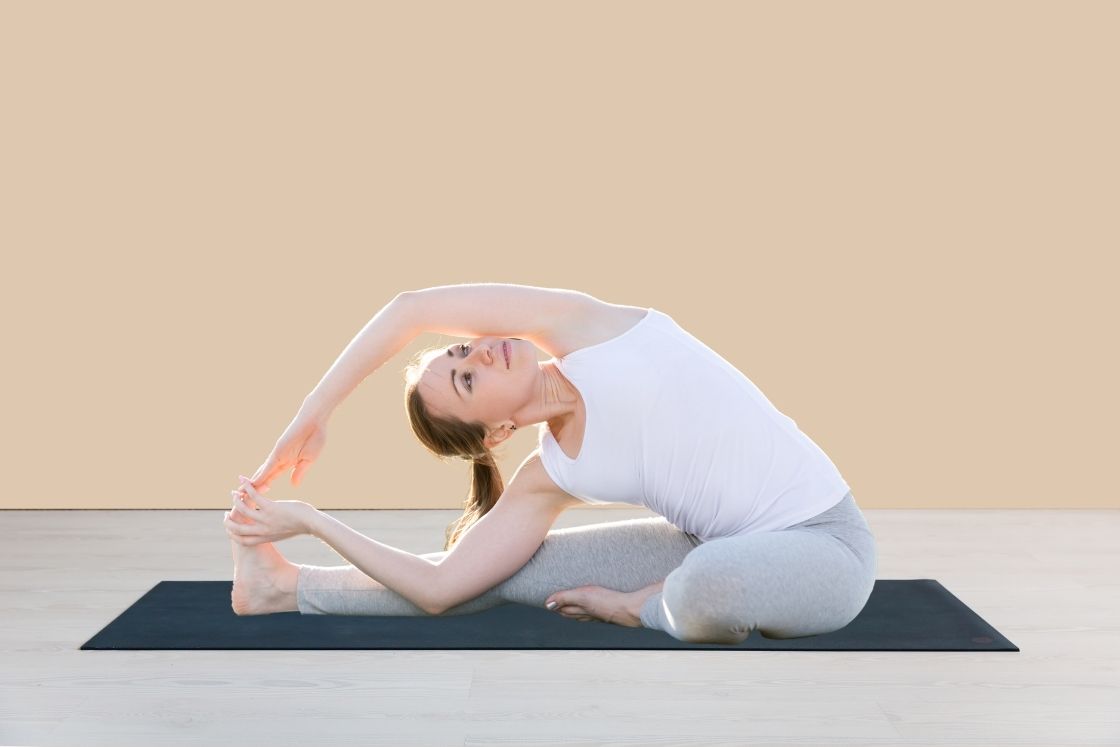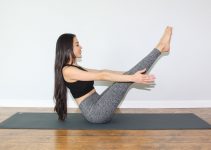
Parivrtta Janu sirsasana is a twisted variation of Janu sirsasana where the spine is bent forward at the same time stretching and twisting sideways. This dynamic action of the pose makes it perfect for the grounded vinyasa sequence.
The pose is categorized into seated intermediate level posture. It involves stretching the spine, forward bending, and again followed with complete awareness and breathing.
People also refer to it as Revolved Head to Knee Pose. It targets the neck, spine, arms, hamstring, and leg muscles.
Therefore, if you are seeking poses to gain full body workout benefits by a seated posture, then Parivrtta janu sirsasana is worth trying.
Meaning
Parivrtta janu sirsasana is a Sanskrit term that clearly explains the pose. Its literal meaning can be derived by its root terms. Here, ‘parivrtta‘ refers to ‘revolved’, ‘janu‘ means ‘knee’, sirsa‘ is ‘head’, and ‘asana’ means ‘pose.’
Holding the pose requires full surrender to the side stretch by bringing the head to the knee and twisting the trunk upwards. It is practiced in a flow and controlled breathing that brings calm to the mind.
Parivrtta Janu Sirsasana Practice Guide
Before getting into the revolved head to knee pose, go through the following contraindications and preparatory poses for safe and ease practice.
Contraindications
- Never practice Parivrtta janu sirsasana when you’re suffering from an upset stomach.
- Avoid it in case of asthma.
- Injury to the hips, knees, back, or shoulders is also a point of concern for practicing this asana.
- Pregnant women must avoid performing this asana.
Preparatory poses
- Head-to-Knee Forward Bend (Janu Sirsasana)
- Downward Facing Dog Pose (Adho Mukha Shvanasana)
- Tree Pose (Vrikshasana)
- Extended Side Angle Pose (Utthita Parsvakonasana)
Parivrtta Janu Sirsasana Steps
- Come over your mat and extend your legs forward in seated dandasana.
- Bend your left knee inwards draw your heel towards the perineum.
- Rotate the upper body towards the right.
- Inhale, raising the arms overhead keeping the back straight, and engage the muscles of your right thigh.
- Exhale and bend towards your right bringing the right arm towards the inside of the thigh. Keep the right elbow to the floor and grab the foot.
- Bend more to reach the right foot with the left hand.
- Now, twist the trunk as far as possible opening the chest and head lying the arms.
- Look towards the ceiling.
- Hold the final posture for five deep breaths.
- Inhale releasing the foot and bringing the arms and upper body up.
- Exhale bring the arms to the floor and rotate to the center.
- Repeat the steps switching the legs.
- Then, stretch both the legs and relax in dadasana.
Cue for Beginners
The pose majorly requires you to maintain contact between your bottom shoulders and inner knee. It is fine if your knee is not straight, as this tendency will be eliminated with practice.
Precautions
- Be mindful while releasing out of the pose to not come up with a twisted upper body. Begin with releasing the upper arm. It will prevent any internal injury.
- Be cautious while rotating the neck. Do not exaggerate the neck twisting, just tilt it in a way that your gaze is fixed at the ceiling.
Modification & Props
- Yoga Strap – Loop a strap over the balls of extended foot. Instead of reaching the foot from hands hold the strap with both your hands keeping the ribs twisted. It will maintain the side stretch and preventing overstretching of hamstrings.
- Using a chair – If you’re unable to go down to reach your head to the knee, extend the foot under a chair. As you go for twisted bending rest your head over the seat grabbing the chair’s leg and the upper part with your hands.
Variations
- Parivratta Janu sirsasana arm variation – Instead of holding the stretched leg with both the hands, keep your alternative hand to put on the bent thigh. However, the stretched foot is grabbed by the alternative hand performing the side stretch.
- Another alteration is keeping the bottom arm stretched forward with palms pressing the floor.
- You can also practice parivratta sirsasana by raising the stretched foot to the ceiling after grabbing it with the hands. The other foot with knee lies near the perineum.
Parivrtta Janu Sirsasana Benefits
In addition to Janu sirsasana effects, this pose increase the blood circulation in the spine and really helpful in back pain issues.
Apart from that, following physical benefits you will observe on doing this pose regularly;
1. Provides strength
Parivratta janu sirsasana opens up the hip and chest muscles. It provides deep side stretches and involves muscles of the neck, shoulders, hamstrings, calves, and ankles. It exerts extreme pressure on them and enhances the blood flow.
This helps the muscles to gain increased oxygen and nutrition. This makes the muscles toned, strong, and enhances their elasticity.
2. Stimulates abdominal organs
Abdominal organs like the kidney and liver experience enormous pressure while holding parivrtta janu sirsasana pose. This enhances their functioning and improves the natural detoxification process of the body.
3. Improves digestion
The abdominal muscles involved in the posture stimulate the digestive system. It is due to the secretion of the stress hormone that activates digestive organs. The pancreas and stomach secrete enough digestive juices and enzymes that improve digestion.
4. Burns belly fat
Due to the contraction of abdominal muscles, parivrtta janu sirsasana acts as a workout. Abdominal muscles experience enormous pressure that helps reduce the extra fat layer.
5. Improves lung capacity
The asana involves twisting the trunk and opening the chest. This expands the rib-cage and enhances lung capacity. It helps in bringing more oxygen to the lungs and improves breathing capacity.
6. Promotes glandular secretion
Paivratta janu sirsasana also exercises the neck muscles. It pressurizes the thyroid as well as the pituitary gland. It maintains the thyroxine secretion. Therefore, it has a therapeutic action on hypo- and hyperthyroidism.
7. Benefits reproductive organs
Parivrtta janu sirsasana exercises and stretches the sexual organs. It increases the amount of blood flow to those regions. This eventually enhances sexual health.
8. Acts as stress buster
This asana is beneficial in improving the blood circulation. It brings sufficient amount of oxygenated blood to the brain. This eradicates all the mental blocks and reduces all the mental disorders like stress, anxiety, etc.





How long one should be in this posture 3mints ok?
The duration to hold Parivrtta Janu Sirsasana can vary depending on the practitioner’s level of experience and comfort in the pose. However, holding the pose for 3 minutes can be a good starting point for intermediate-level practitioners. It is important to listen to your body and gradually increase the duration of holding the pose as your body allows. Always consult with a qualified yoga teacher for proper guidance and alignment in the pose.